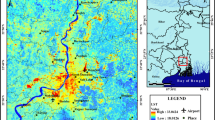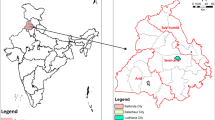Abstract
A surface urban heat island (SUHI) is a significant meteorological phenomenon of the microclimate and environment in urban territories. Knowledge about the variations of SUHI is critical for urban planning and public welfare. In the current study, the seasonal and spatial changes of the Istanbul SUHI and its interactions with spectral indicators of the urban heat phenomenon including the normalized difference vegetation index (NDVI), tasseled cap wetness (TCW), and surface albedo were analyzed. The National Aeronautics and Space Administration (NASA) L2 thermal products (brightness temperature) of Landsat 8 imageries were used to calculate land surface temperature (LST) values. The thermal islands of the study area were detected based on the Urban Thermal Field Variation Index method. The retrieved LST values showed acceptable agreement with in situ observations of mean daily temperature for all the seasons. Monthly precipitation, however, demonstrated good correlation with summer and autumn LSTs. It is found that the central parts of the metropolitan area were subject to the most intense SUHI in the spring and summer seasons. Outskirt areas showed higher thermal values during cooler seasons of autumn and winter. The results of spatio-temporal interactions of SUHI and the spectral indicators revealed a negative correlation for NDVI and TCW and a positive correlation for surface albedo during different seasons from summer 2017 to spring 2018. The highest and lowest correlations were found between SUHI and TCW (spring) and surface albedo (winter), respectively. The regression results overall suggested that TCW and NDVI were the best indicators of SUHI in Istanbul. Surface albedo was not recommended for seasonal monitoring practices of SUHI in the study area due to the high differences in its seasonal interactions.





Similar content being viewed by others
References
Baig, M. H. A., Zhang, L., Shuai, T., & Tong, Q. (2014). Derivation of a tasselled cap transformation based on Landsat 8 at-satellite reflectance. Remote Sensing Letters, 5(5), 423–431. https://doi.org/10.1080/2150704X.2014.915434.
Baldinelli, G., Bonafoni, S., & Rotili, A. (2017). Albedo retrieval from multispectral Landsat 8 observation in urban environment: algorithm validation by in situ measurements. IEEE Journal of Selected Topics in Applied Earth Observations and Remote Sensing, 10(10), 4504–4511.
Calò, F., Abdikan, S., Görüm, T., Pepe, A., Kiliç, H., & Balik Şanli, F. (2015). The space-borne SBAS-DInSAR technique as a supporting tool for sustainable urban policies: the case of Istanbul megacity, Turkey. Remote Sensing, 7(12), 16519–16536.
Cui, Y. Y., & De Foy, B. (2012). Seasonal variations of the urban heat island at the surface and the near-surface and reductions due to urban vegetation in Mexico City. Journal of Applied Meteorology and Climatology, 51(5), 855–868.
Duan, S. B., Li, Z. L., Wang, C., Zhang, S., Tang, B. H., Leng, P., & Gao, M. F. (2019). Land-surface temperature retrieval from Landsat 8 single-channel thermal infrared data in combination with NCEP reanalysis data and ASTER GED product. International Journal of Remote Sensing, 40(5–6), 1763–1778.
Favretto, A. (2018). Urban heat island analysis with remote sensing and GIS methods: an application in the Trieste area (north-east of Italy). Bollettino Della Società Geografica Italiana Serie, 1(1), 215–229.
Guide, P. (2018). Landsat 8 surface reflectance code (LaSRC) product. Available online: https://landsat.usgs.gov/sites/default/files/documents/lasrc_product_guide.pdf. Accessed: 06.12.2019.
Haashemi, S., Weng, Q., Darvishi, A., & Alavipanah, S. (2016). Seasonal variations of the surface urban heat island in a semi-arid city. Remote Sensing, 8(4), 352.
Jiménez-Muñoz, J. C., Cristóbal, J., Sobrino, J. A., Sòria, G., Ninyerola, M., & Pons, X. (2008). Revision of the single-channel algorithm for land surface temperature retrieval from Landsat thermal-infrared data. IEEE Transactions on Geoscience and Remote Sensing, 47(1), 339–349.
Jin, S., & Sader, S. A. (2005). Comparison of time series tasseled cap wetness and the normalized difference moisture index in detecting forest disturbances. Remote Sensing of Environment, 94(3), 364–372.
Jongtanom, Y., Kositanont, C., & Baulert, S. (2011). Temporal variations of urban heat island intensity in three major cities, Thailand. Modern Applied Science, 5(5), 105.
Jouybari-Moghaddam, Y., & Saradjian, M. R. (2019). A semi-empirical approach for the estimation of land-surface emissivity from satellite data based on spectral index fusion using ensemble regression. International Journal of Remote Sensing, 40(11), 4213–4243.
Kaplan, G., Avdan, U., & Avdan, Z. Y. (2018). Urban heat island analysis using the Landsat 8 satellite data: a case study in Skopje, Macedonia. In Multidisciplinary Digital Publishing Institute Proceedings Vol. 2, No. 7, p. 358.
Kaya, A., & Koc, M. (2019). Over-agglomeration and its effects on sustainable development: a case study on Istanbul. Sustainability, 11(1), 135.
Khorrami, B., Gunduz, O., Patel, N., Ghouzlane, S., & Najjar, M. (2019). Land surface temperature anomalies in response to changes in forest cover. International Journal of Engineering and Geosciences, 4(3), 149–156.
Liang, S. (2001). Narrowband to broadband conversions of land surface albedo I: algorithms. Remote Sensing of Environment, 76(2), 213–238.
Liu, Q., Liu, G., & Huang, C. (2018). Monitoring desertification processes in Mongolian plateau using MODIS tasseled cap transformation and TGSI time series. Journal of Arid Land, 10(1), 12–26.
Luis, A. L., Pandit, P. H., & Jawak, S. D. (2018). Extraction of blue ice area using albedo value derived from Landsat-8 satellite data. ISPRS Journal of Photogrammetry and Remote Sensing XLII-5, 549–552. https://doi.org/10.5194/isprs-archives-XLII-5-549-2018
Macarof, P., & Statescu, F. (2017). Comparison of ndbi and ndvi as indicators of surface urban heat island effect in Landsat 8 imagery: a case study of Iasi. Present Environment and Sustainable Development, 11(2), 141–150.
Miles, V., & Esau, I. (2017). Seasonal and spatial characteristics of urban heat islands (UHIs) in northern West Siberian cities. Remote Sensing, 9(10), 989.
Nakamura, Y., Shigeta, Y., & Watarai, Y. (2018). Seasonal variations of the urban heat island in Kumagaya, Japan. Geographical review of Japan series B, 91(2), 29–39.
Ogashawara, I., & Bastos, V. (2012). A quantitative approach for analyzing the relationship between urban heat islands and land cover. Remote Sensing, 4(11), 3596–3618.
Parastatidis, D., Mitraka, Z., Chrysoulakis, N., & Abrams, M. (2017). Online global land surface temperature estimation from Landsat. Remote Sensing, 9(12), 1208.
Renard, F., Alonso, L., Fitts, Y., Hadjiosif, A., & Comby, J. (2019). Evaluation of the effect of urban redevelopment on surface urban heat islands. Remote Sensing, 11(3), 299.
Schatz, J., & Kucharik, C. J. (2014). Seasonality of the urban heat island effect in Madison, Wisconsin. Journal of Applied Meteorology and Climatology, 53(10), 2371–2386.
Sensoy, S., Demircan, M., Ulupinar, Y., & Balta, İ. (2008). Climate of Turkey. Turkish state meteorological service, 401. https://www.researchgate.net/publication/296597022_Climate_of_Turkey. Accessed: 06.12.2019.
Singh, R., Grover, A., & Zhan, J. (2014). Inter-seasonal variations of surface temperature in the urbanized environment of Delhi using Landsat thermal data. Energies, 7(3), 1811–1828.
Smith, R. B. (2010). The heat budget of the earth’s surface deduced from space. New Haven: Yale University Center for Earth Observation.
The Glob Temperature Consortium (2016). Satellite LST user handbook. GlobT-WP3-DEL-25, V1. www.globtemperature.info › deliverables-1 › 215-lst-handbook › file.
Touchaei, A. G., Akbari, H., & Tessum, C. W. (2016). Effects of increasing urban albedo on meteorology and air quality Montreal (Canada)—episodic simulation of heat wave in 2005. Atmospheric Environment, 132, 188–206.
TSMS, (2019). The Turkish State Meteorological Service, ISTANBUL statistics. https://www.mgm.gov.tr/veridegerlendirme/il-ve-ilceler-istatistik.aspx?m=ISTANBUL. Accessed: 06.12.2019.
USGS EROS Customer Services (2019). Landsat collection 1. USGS EROS Customer Services. https://www.usgs.gov/land-resources/nli/landsat/landsat-collection-1?qt-science_support_page_related_con=1#qt- cience_support_page_related_con. Accessed: 06.12.2019.
Vorovencii I. (2007). Use of the “tasseled cap” transformation for the interpretation of satellite images. (online resource): http://revcad.uab.ro/upload/16_225_Paper6_RevCAD07_2007.pdf. Accessed: 06.12.2019.
Wang, S., Xiang, M., He, Y., Tsou, J., Zhang, Y., Liang, X.S., & Lu, X. (2018). Evaluating urban heat island effects in rapidly developing coastal cities, Coastal environment, disaster, and infrastructure - a case study of China's coastline, X. San Liang and Yuanzhi Zhang, IntechOpen. https://doi.org/10.5772/intechopen.80020.
Yu, X., Guo, X., & Wu, Z. (2014). Land surface temperature retrieval from Landsat 8 TIRS—Comparison between radiative transfer equation-based method, split window algorithm and single channel method. Remote Sensing, 6(10), 9829–9852.
Yuan, F., & Bauer, M. E. (2007). Comparison of impervious surface area and normalized difference vegetation index as indicators of surface urban heat island effects in Landsat imagery. Remote Sensing of Environment, 106(3), 375–386.
Zhao, W., Zhu, X., Jiang, G., & Gao, Z. (2018). Seasonal variation and land-use/land-cover type impacts on the correlation of urban heat island intensity and difference vegetation index with satellite data in Xi’an, China. Wuhan University Journal of Natural Sciences, 23(5), 387–395.
Zhou, D., Xiao, J., Bonafoni, S., Berger, C., Deilami, K., Zhou, Y., & Sobrino, J. A. (2019). Satellite remote sensing of surface urban heat islands: progress, challenges, and perspectives. Remote Sensing, 11(1), 48.
Author information
Authors and Affiliations
Corresponding author
Additional information
Publisher’s note
Springer Nature remains neutral with regard to jurisdictional claims in published maps and institutional affiliations.
Rights and permissions
About this article
Cite this article
Khorrami, B., Gunduz, O. Spatio-temporal interactions of surface urban heat island and its spectral indicators: a case study from Istanbul metropolitan area, Turkey. Environ Monit Assess 192, 386 (2020). https://doi.org/10.1007/s10661-020-08322-1
Received:
Accepted:
Published:
DOI: https://doi.org/10.1007/s10661-020-08322-1




